Something went wrong!
Hang in there while we get back on track
Best attractions in Sicily
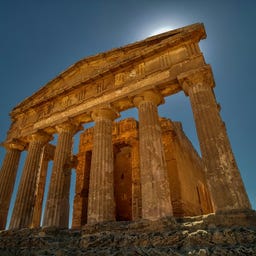
Sicily is a place full of fascinating wonders, from majestic ancient ruins to breathtaking natural landscapes. Particularly impressive is Mount Etna, Europe's most active volcano, whose massive eruptions and lava landscapes offer a unique natural spectacle. Another highlight is the Valley of the Temples in Agrigento, where well-preserved Greek temples like the Temple of Concordia from the 5th century BC stand proudly. Additionally, the picturesque beaches of San Vito Lo Capo with their turquoise waters and fine sand are perfect for relaxation.
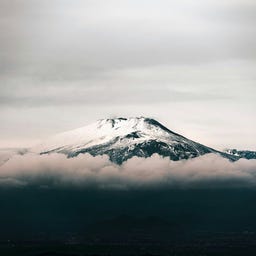
Everything that nature has that is great, everything that is pleasant, everything that is terrible, can be compared to Etna and Etna cannot be compared to anything. (Dominique Vivand Denon, 1788)
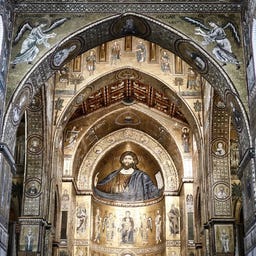
Monreale Cathedral, considered the most magnificent example of Arab-Norman architecture in Sicily, dazzles visitors with its intricate gold mosaics. These vast mosaics, requiring over 1800 kg of gold, cover over 6,500 square meters and presents 42 biblical tales in stunning detail. Only an hour's bus ride from Palermo, this UNESCO World Heritage Site is a must-see in Palermo.
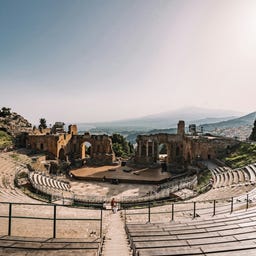
The ancient Greek theatre of Taormina, located just a five-minute walk from Villa Comunale on 1, Via del Teatro Greco, is the town's crowning jewel and a must-see attraction for any visitor. Founded in the 3rd century BC, it stands out not just for its historical significance as the second largest Greek theatre in Sicily but also for the breathtaking views it offers of Mount Etna and the Ionian Sea.
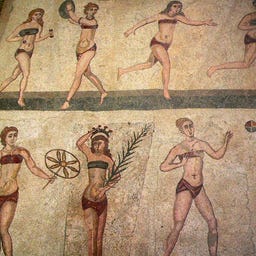
The Roman villa near Piazza Armerina is renowned for its stunning collection of well-preserved mosaics that vividly capture life in the Roman Empire. Built in the 4th century AD, the villa boasts about 3,500 square meters of mosaics, showcasing scenes from mythology, the earliest bikini fashion, hunting expeditions, and daily life.
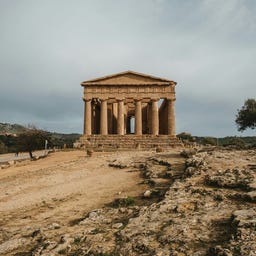
The archaeological park near Agrigento is an outstanding example of ancient Greek architecture and a UNESCO World Heritage Site. The well-preserved Temple of Concordia, with its majestic Doric columns, stands out. Nearby, the Temple of Zeus Olympius is famous for its colossal Atlantes statues. A popular photo spot is the Statue of Icarus in front of the Temple of Concordia, symbolizing the mythological hero’s dramatic fall.

Ortygia, the historic heart of Syracuse, is one of Sicily's most beautiful gems. This enchanting island, connected to the mainland by two bridges, boasts a rich history spanning thousands of years, with ancient ruins, baroque splendor, and vibrant street markets.
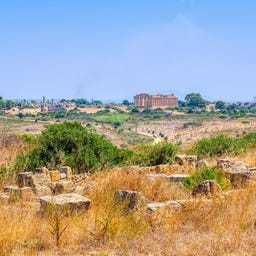
Located on the southwestern coast of Sicily, Selinunte is not only the largest archaeological park in Sicily but also the largest in Europe, spanning 270 hectares. Selinunte was founded in the 7th century BC and thrived until its destruction by the Carthaginians in 409 BC. The park is known for its extensive ruins, which include 7 temples built in the Greek Doric style. Of these, Temple E is the most restored and impressive, while Temple C, dedicated to Apollo, is the oldest, dating back to 560-550 BC.

Lo Zingaro Nature Reserve, a pristine coastal haven on Sicily's northwest shore, invites hikers and nature lovers to its rugged landscapes and serene coves. This first natural reserve set up in Sicily in 1981, protects a flourishing biodiversity of over 40 bird species and 700 species of Mediterranean flora.

With its unique Arab-Norman architectural style, the Cathedral captivates the eye of any visitor. Admire the unconventional exterior, adorned with elegant arches, detailed Islamic-style geometric patterns and richly decorated towers. For breathtaking panoramic city views, climb to the rooftop during sunset. It’s one of the city’s top experiences.
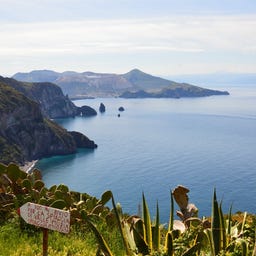
The Aeolian Islands, a UNESCO World Heritage Site off Sicily’s northern coast, are among the Mediterranean’s most beautiful destinations. This volcanic archipelago of seven islands offers each visitor a unique charm.
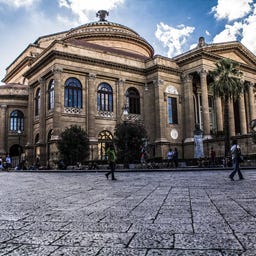
Teatro Massimo stands as a monumental opera house, celebrated for its grandeur and acoustic excellence. As Italy's largest and Europe's second-largest opera venue, it is a cornerstone of cultural heritage, famous not only for its neoclassical elegance but also as a filming location for notable movies like "The Godfather: Part III".
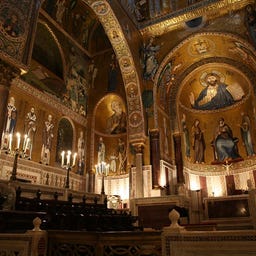
The chapel from the 12th century, a stunning example of Norman architecture, is Palermo's top attraction. It impresses with its fine Byzantine gold mosaics, an exquisite ceiling in the Arabic style, and beautiful marble inlays. This unique combination reflects the cultural fusion of Sicily under Norman rule. You'll find this gem on the middle level of the Palazzo dei Normanni.
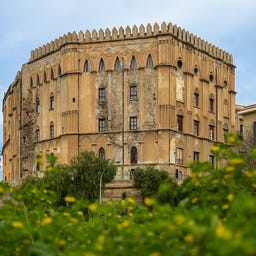
The Norman Palace is Europe’s oldest royal residences and a must-see in Palermo. Originally erected as a 9th-century Arab fortress, the Normans expanded it into a striking example of medieval architecture. The highlight is the Palatine Chapel, renowned for its exquisite Byzantine artistry, with dazzling gold mosaics and intricate Arabic-style woodwork. The best rooms within the Royal Apartments are the mosaic-lined Sala dei Venti and King Roger's 12th-century bedroom, Sala di Ruggero II. The botanical palace gardens with their tropical trees offer you a place to rest before you venture out again.
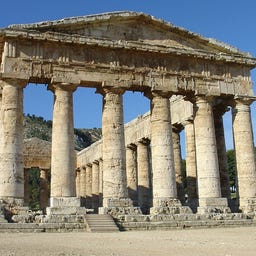
The Archaeological Park of Segesta is one of Sicily's top attractions. It offers a fascinating glimpse into the ancient world of the Elymians, one of the island's oldest cultures. The park's highlight is the well-preserved Doric temple from the 5th century BC, majestically perched on a hill and surrounded by stunning Mediterranean landscapes.

In the Parco dell'Etna, a nature reserve established in 1987 in Sicily, you can expect a unique volcanic landscape with over 200 lava caves. Spanning an area of 58,095 hectares, you'll find not only the famous Grotta del Gelo with its year-round ice but also the Grotta dei Tre Livelli, one of the longest lava caves in the world. The park, which covers 20 municipalities, is home to an extraordinary flora with endemic species like the Etna birch and the renowned Etna vineyards. You can explore the various areas of the park via a well-developed network of trails and the historic Ferrovia Circumetnea, a circular railway at the foot of the volcano, as long as there is no current volcanic activity restricting the routes.
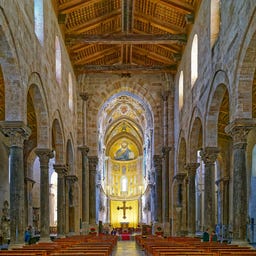
Majestically, the Duomo di Cefalù rises above the Sicilian coastal town - an impressive testament to Norman-Arab-Byzantine architecture from the 12th century. The cathedral, begun by Roger II. in 1131, captivates with its distinctive double-tower façade and houses magnificent Byzantine mosaics covering over 600 square meters, with the highlight being the imposing Christ Pantocrator in the presbytery.
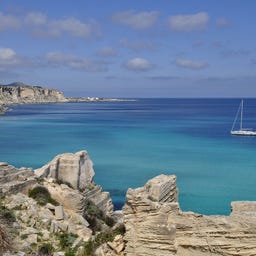
Favignana, the largest island in the Aegadian Archipelago off Sicily’s west coast, is a Mediterranean paradise renowned for its crystal-clear waters and scenic beaches. Just a short ferry ride from Trapani, it’s ideal even for a day trip.

The Duomo di Siracusa, also known as the Cattedrale della Natività di Maria Santissima, is an exceptional fusion of Greek, Byzantine, and Baroque architectural styles. You can still admire the original Doric columns of the ancient temple, built by the tyrant Gelon in the 5th century BC to commemorate his victory over the Carthaginians. The cathedral has a tumultuous history - it was the first Christian church in the West, was temporarily converted into a mosque, and after the devastating earthquake of 1693, it received its current Baroque facade with the distinctive Corinthian columns.
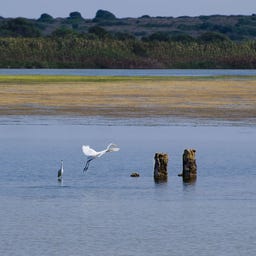
The beautiful natural reserve located along the southeastern coast of Sicily is known for its diverse ecosystems. It features sandy beaches, rocky coastlines, salt marshes, and Mediterranean scrub. Birdwatchers flock here to observe migratory species such as flamingos, herons, and storks.

Etnaland is a popular amusement park in Belpasso, Sicily that offers exciting experiences for the whole family. Combining a water park, theme park, and dinosaur-themed attractions, Etnaland features a wide range of rides, slides, and interactive shows in a picturesque setting. There's something for everyone! Located near Catania, it’s the perfect destination for a family day trip.
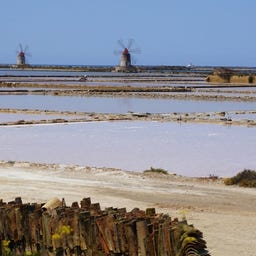
Off the west coast of Sicily, in the province of Trapani, lies the largest lagoon of the island with its four distinctive islands: Isole dello Stagnone. In the extremely shallow waters—often only knee-deep—you'll find the islands Isola Grande, La Scuola, Santa Maria, and San Pantaleo. The largest of them, Isola Grande, originally consisted of five smaller islands connected by canals.
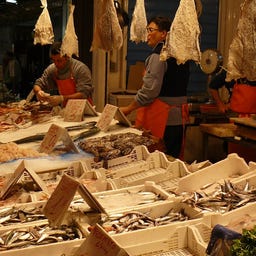
Dive into the heart of Sicilian culture and sample the delicious street food. Mercato di Ballarò, the largest among Palermo's markets, carries a rich history dating back to Arab times. Here, the air is filled with the scent of local spices, and the tantalizing aromas of Sicilian street food. From the iconic arancini (rice balls) to pane e panelle (famous chickpea fritters), and crocche, potato croquettes, every bite is a treat.

Quattro Canti, also known as Piazza Vigliena, is a renowned Baroque square located in the heart of Palermo. Positioned at the intersection of Via Maqueda and Corso Vittorio Emanuele, it forms the heart of the city's four ancient quarters: Kalsa, Seralcadi, Albergaria, and Castellammare.
Constructed between 1608 and 1620 by architects Giulio Lasso and Mariano Smiriglio, Quattro Canti features an octagonal design. The square's architecture showcases nearly symmetric, concave facades, each divided in three classical orders and beautifully embellished with statues:

The circular Fonte Aretusa on the island of Ortigia is one of the most famous freshwater springs in Sicily and has been closely linked to the history of Syracuse since ancient times. Here, crystal-clear groundwater emerges in a distinctive double basin, surrounded by one of the few colonies of papyrus reeds in Europe.

The Temple of Apollo, constructed in the early 6th century BC, stands as the oldest Doric temple in Sicily. Originally crafted from massive monoliths, it marks the transition from wooden to stone structures and showcases unique architectural features like a double colonnade on the east side.

The Archaeological Park of Neapolis showcases the grandeur of ancient Greco-Roman history. At its heart lies the monumental Greek theater, one of the largest of its kind, built in the 5th century BC. The park also features the Orecchio di Dionisio, a striking man-made cave renowned for its acoustics. Completing the park’s highlights is the Roman amphitheater from the 3rd century AD, once a venue for gladiatorial contests.
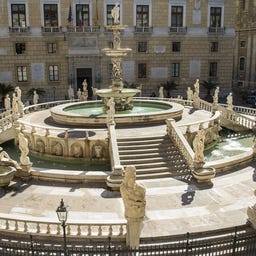
In the heart of Palermo's historic center, you'll find the Fontana di Piazza Pretoria, one of the most elaborate fountain complexes in Italy. This monumental fountain, created in 1554 by Francesco Camilliani in Florence and transported to Sicily in 644 individual pieces in 1574, impresses with its pyramid-shaped design featuring 48 intricately detailed statues of mythological figures.

Hidden within the ancient Latomia del Paradiso lies this remarkable limestone cave - 23 meters high and 65 meters deep. For centuries, it has captivated people with its exceptional acoustics and poignant history. It was Caravaggio, in 1608, who bestowed its name, inspired by the cave's ear-like shape and the legends surrounding Dionysius.
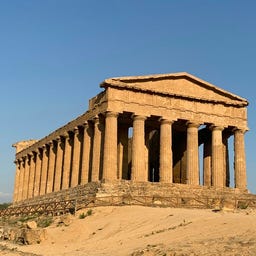
In the Sicilian Valle dei Templi, you will find the Tempio della Concordia, one of the best-preserved Doric temples in the world - a masterpiece of Greek architecture from the 5th century BC. Built on a massive foundation, this structure impresses with its perfect proportions, featuring 6x13 columns and a height of over 13 meters.

The impressive rock formation on the coast of Realmonte is known for its bright white, step-like cliffs. These marl cliffs, jutting into the sea like a giant natural staircase, offer a stunning spectacle, especially in the light of the setting sun.

In the Chiesa del Gesù, also known as the Casa Professa, you will find one of the most significant Baroque churches in Palermo, built between 1590 and 1636. This impressive church, inspired by the Roman Gesù Church, features a single-nave architecture with large side chapels and elaborate marble and stucco decorations inside.
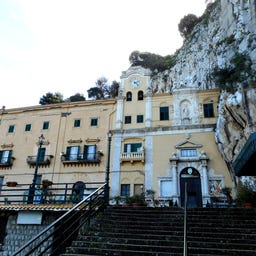
High above Palermo, at an altitude of 429 meters, stands the Santuario di Santa Rosalia, a fascinating sanctuary from the 17th century built directly into a rock niche. The discovery of the remains of Santa Rosalia in 1624, who, according to tradition, helped the city overcome the plague, turned this already revered site, known as holy since the 13th century, into the most important pilgrimage destination in Palermo.

The Lighthouse of the Mediterranean, one of the most captivating islands in the Aeolian Archipelago, is known for its constantly active volcano, which offers regular small eruptions. Adventurers can take guided hikes to the summit to witness the Sciara del Fuoco, a glowing lava flow that cascades dramatically into the sea.
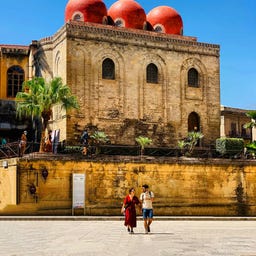
The Chiesa di San Cataldo in Palermo is one of the most impressive examples of Arab-Norman architecture in Sicily, recognizable by its distinctive three red domes and the compact sandstone facade with Islamic-inspired blind arches. Founded between 1154 and 1160 by Majone di Bari, the church has a tumultuous history, having served as a Benedictine monastery and later as a post office in the 19th century.

In the middle of Piazza Archimede in Syracuse stands the monumental Fontana di Diana, an impressive testament to the early 20th century. Created by Giulio Moschetti between 1906 and 1907, the fountain features the hunting goddess Diana with her bow and arrow, surrounded by the mythological scene of Aretusa transforming into a spring.
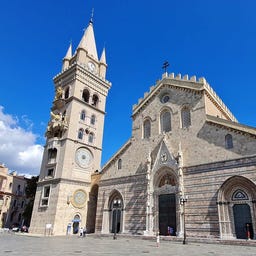
The Duomo di Messina is an impressive cathedral in the heart of Sicily that has been rebuilt time and again despite multiple destructions from earthquakes and war damage. The grand facade combines Romanesque, Norman, and Gothic elements into a harmonious whole, while inside, you’ll find 23 richly decorated altars and the second-largest organ in Italy waiting for you.

The Cattedrale di Sant'Agata in the heart of Catania combines Norman, Baroque, and Neoclassical architectural elements into an impressive work of art. Originally built in the 11th century and rebuilt several times after earthquakes, the cathedral now features a magnificent Carrara marble facade and intricately carved main portals.

The Elephant Fountain can be found on the Piazza del Duomo, and is an iconic symbol of the city. Featuring a unique black basalt elephant, affectionately known as 'Liotru', it carries an ancient Egyptian obelisk, rumored to hold magical protective powers against Mount Etna's eruptions.
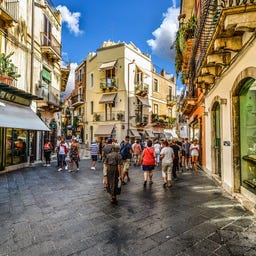
The main charm of Taormina is walking along Corso Umberto I, a pedestrian friendly street flanked by boutiques and cafes. Start your town walk at Palazzo Corvaja before heading southwest to soak in the fabulous panoramas from Piazza IX Aprile. Here, you can visit the Chiesa di San Giuseppe from the early 18th century. Wander further to the Torre dell'Orologio, a 12th-century clock tower, leading to the Piazza del Duomo. This square is adorned with a baroque fountain from 1635, featuring Taormina's emblematic centaur.

Built in ancient Greece and impressively preserved to this day, the Teatro greco di Siracusa is one of the oldest theaters in the Western world. Carved into the rock in the 5th century BC, this amphitheater once accommodated up to 15,000 spectators and was used for performances by great playwrights like Aeschylus and Euripides.

In the Chiesa della Martorana in the historic center of Palermo, you will find a fascinating blend of Byzantine, Norman, and Baroque architecture. Founded in 1143 by Giorgio d'Antiochia, a Byzantine admiral in the service of the Norman king Roger II., the church has been a UNESCO World Heritage Site since 2015, recognized for its Arab-Norman architectural monuments in Palermo.
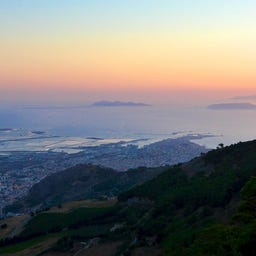
Off the west coast of Sicily, just 7 km from Trapani, you will find the unspoiled Aegadian Islands, an archipelago featuring the three main islands of Favignana, Marettimo, and Levanzo. Known since ancient times as the "Islands of Goats," these islands were the site of significant history—here, in 241 BC, the first Punic War battle between Rome and Carthage took place.
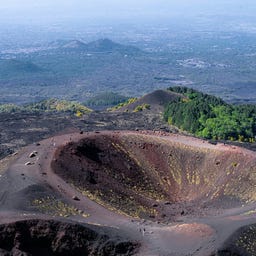
The two prominent volcanic cones of Monti Silvestri, named after the volcanologist Orazio Silvestri, were formed during a 173-day eruption in 1892 on the southern side of Etna. Located at an altitude of about 1,900 meters, the craters are now easily accessible via the provincial road SP 92, which runs between the upper and lower cones.

The majestic Cattedrale di Noto stands on an impressive staircase in the heart of the Sicilian Baroque city and is the most significant Catholic church in the region. Built between 1694 and 1703, it combines late Baroque splendor with classical elements and was designated a UNESCO World Heritage Site in 2002 as part of the "Late Baroque Towns of the Val di Noto."

In the Sicilian Valley of the Temples, the Tempio di Giunone stands, a Doric temple from the 5th century BC that was originally dedicated to the goddess Athena. Located at a height of 120 meters, the structure impresses with its 34 columns, which rise from a four-tiered base and reach a height of 6.44 meters. After a fire in 406 BC, the temple was restored during the Roman period, and its weathering was later documented by Johann Wolfgang von Goethe during his travels. In front of the impressive eastern facade, you can still see the remains of the original altar, while the temple itself has been preserved since the 18th century through careful reconstruction efforts.

The monumental Basilica Santuario Madonna delle Lacrime in Syracuse rises 103 meters into the Sicilian sky with its distinctive concrete cone architecture. This modern sacred building, consecrated by Pope John Paul II in 1994, was created in response to an extraordinary event: in 1953, a plaster statue of the Madonna wept tears for several days, attracting thousands of believers. In the spacious basilica, which can accommodate up to 11,000 people, you will find not only the original Madonna image but also valuable artworks like an 18th-century wooden crucifix. As the only regional Marian shrine in Sicily, the basilica remains an important pilgrimage site and spiritual center of the island to this day.
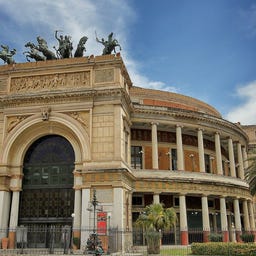
The Teatro Politeama Garibaldi in the heart of Palermo is one of the most important theaters in Sicily, embodying the cultural spirit of the city since its opening in 1874. The impressive building, designed by architect Giuseppe Damiani Almeyda, features a semi-circular façade with a triumphal arch entrance, topped by a bronze quadriga of Apollo created by artist Mario Rutelli.
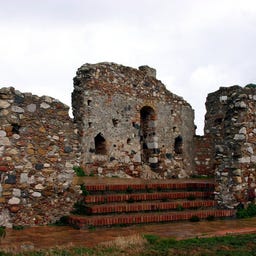
Castello di Mola offers a rewarding experience for those willing to make the hike. Located near Taormina, it requires appr. an 1 hour and 45 minutes hike from the train station. While only few walls are left standing from the castle, the location provides spectacular views of Mount Etna and the surrounding area, a quaint village, and a nice stop for a picnic.
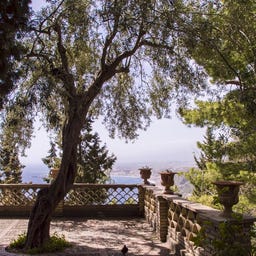
The Taormina Public Garden is a beautiful retreat established by Englishwoman Florence Trevelyan in the late 19th century. Beloved for its panoramic views of the Sicilian coast and Mount Etna, the garden is home to a diverse collection of tropical plants, delicate flowers, and curious constructions.
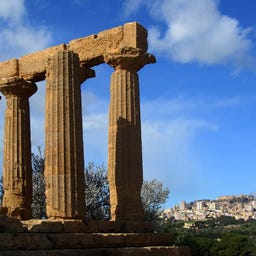
In the Sicilian city of Agrigento, you can explore one of the most significant ancient sites in the world: the Valley of the Temples, a UNESCO World Heritage site featuring impressive Greek temples from the 5th century BC. Originally founded as Akragas, the city flourished under the Greeks and was later influenced by Romans, Byzantines, Arabs, and Normans, which is reflected in its diverse architecture to this day.
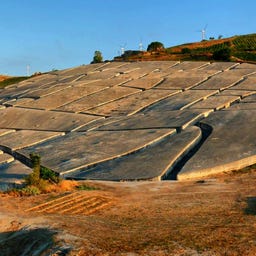
At first glance, you see just a huge labyrinth of bright concrete, but the Cretto di Burri is one of the largest artworks in the world - an 80,000 square meter memorial for the city of Gibellina, which was destroyed by an earthquake in 1968. The Italian artist Alberto Burri immortalized the original city layout by casting the rubble of the destroyed buildings into massive concrete blocks and recreating the former streets with two to three meter wide cracks.
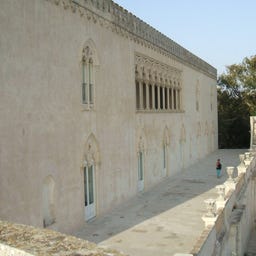
On a hill 15 kilometers from Ragusa stands the impressive Castello di Donnafugata, whose history dates back to the 14th century with the Chiaramonte family. The castle's current neo-Gothic appearance, featuring its characteristic towers and monumental staircase, is largely due to renovations by Baron Corrado Arezzo de Spuches in the 19th century.
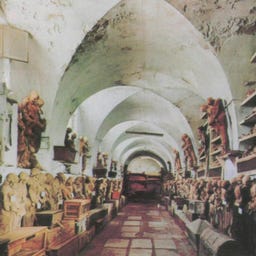
The underground cemetery, established in the 16th century, houses over 8,000 mummified bodies, dressed in their finest clothes and displayed along the walls. The catacombs provide a macabre yet insightful glimpse into Sicilian cultural practices, beliefs about death, and the methods of preserving the deceased. A visit is certainly not for the faint-hearted but undeniably offers an extraordinary experience.
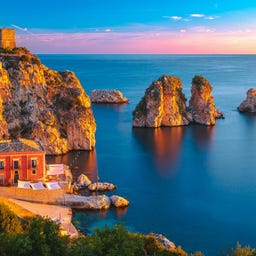
On the picturesque coast near Castellammare del Golfo, you will discover the Tonnara di Scopello, one of the most significant historical tuna fisheries in Sicily. The site, with its first documented activities dating back to 1312, was significantly expanded in the 15th and 16th centuries by the Sanclemente family and later taken over by the Florio family.
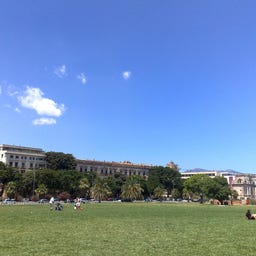
On the coast of Palermo, you'll find the Foro Italico, a vast green space covering 40,000 m² of lawn that stretches from the La Cala harbor to the Villa Giulia in the Kalsa district.

The Riserva Naturale Orientata Capo Gallo is a 586-hectare nature reserve on the Sicilian coast that has been protected since 2001. In this diverse habitat, you can find endemic species like the Sicilian shrew and a unique coastal formation made of mollusk shells, known as "Trottoir a Vermeti." Caves shaped by the sea, such as the Grotta dell'olio, and archaeological sites reflect the rich history of the area. You can explore the restored hiking trails and discover the natural beauty of the reserve via various access routes, such as from Torre di Mondello or Contrada Barcarello.
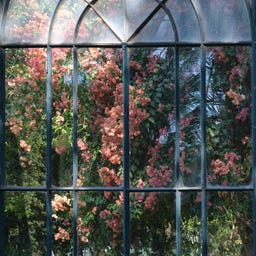
In the Orto botanico di Palermo, one of the most significant botanical gardens in Italy, you can explore over 12,000 different plant species spread across 10 hectares of park-like grounds. Founded in 1779 as a medicinal herb garden, the park impressed Johann Wolfgang von Goethe during his visit in 1787, calling it a "magical place."

Perched atop Ortygia Island, the fortress is a stunning example of medieval military architecture, offering expansive sea views. Built between 1232 and 1240 by Emperor Frederick II, its massive walls, four cylindrical towers, and magnificent marble entrance adorned with intricate arches and sculptures are truly impressive.
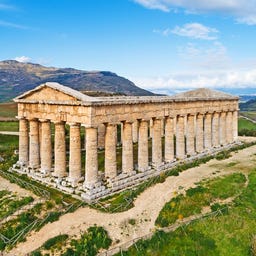
Majestically, the Tempio Grande of Segesta rises above the hilly landscape of western Sicily - one of the best-preserved Greek temples in the world from the late 5th century BC. With its 36 impressive columns, each 10 meters high, it is a masterpiece of ancient architecture that even Goethe admired on his Grand Tour. An inscription discovered in 2020 confirms that the temple was dedicated to Aphrodite Urania. What makes it special is that the temple was built without the usual inner sanctum (Cella) - a mystery that continues to intrigue archaeologists to this day.

Isola Bella, the Pearl of the Ionian Sea, is just off the coast of Taormina and a real gem for visitors. This tiny island, connected to the mainland by a narrow strip of sand, serves as a beautiful nature reserve. Despite its popularity, Isola Bella remains an idyllic spot.

In the magnificent Teatro Massimo Vincenzo Bellini in Catania, you will find one of the most beautiful opera houses in Italy from the 19th century, renowned for its exceptional acoustics. The theater, built in the style of the French Second Empire, impresses with its horseshoe-shaped auditorium featuring four tiers and an elaborately decorated interior, crowned by Ernesto Bellandi's stunning ceiling fresco.
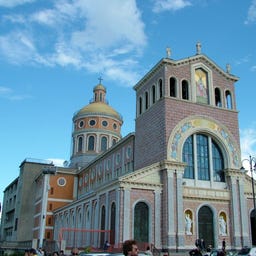
Majestically, the Basilica Santuario di Maria Santissima del Tindari sits on a hill overlooking the Marinello lagoons, where the Greek colony of Tyndaris was founded as early as the 4th century BC. The modern church, built between the 1950s and 70s, houses the famous statue of the Black Madonna, which, according to legend, was brought to this place by a storm. With its three-nave basilica, distinctive bell tower, and dome covered in blue ceramic tiles, the sanctuary is now one of the most important pilgrimage sites in Sicily. From the terrace, you can enjoy a breathtaking view of the coast and the Tyrrhenian Sea, while the ruins of the ancient city of Tyndaris stretch out right next door.
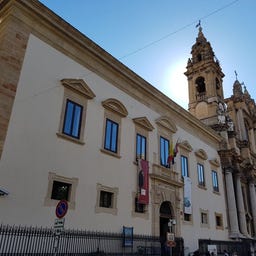
In the former monastery building from the 16th/17th century, you will find one of the most significant archaeological collections in Italy, documenting the history of Sicily from prehistoric times to the Middle Ages. The museum, named after the archaeologist Antonino Salinas, houses impressive artifacts from various cultures - from the Phoenicians to the Greeks and Romans - and was reopened in 2016 after extensive renovations.
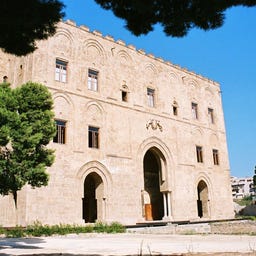
In the west of Palermo stands La Zisa, a fascinating Norman-Arab palace from the 12th century, whose name comes from the Arabic "al-ʿAzīza" (the Magnificent). Built as a summer residence by King William I. starting in 1165, it uniquely combines Arab and Norman architectural elements and features a sophisticated ventilation system that makes optimal use of sea breezes. You can particularly appreciate the former splendor of the palace in the famous Sala della Fontana, with its ornate vaulted ceiling and decorative niches. Today, this meticulously restored building, which became a UNESCO World Heritage site in 1991, houses the Museum of Islamic Art.
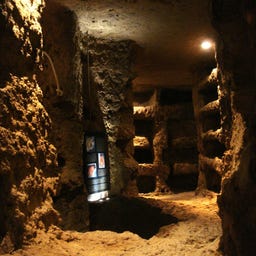
Deep beneath the streets of Syracuse lies a vast network of early Christian catacombs from the 3rd and 4th centuries, second in significance and size only to those in Rome. The Catacombs of San Giovanni, the only ones open to the public, present themselves as an underground city with streets, squares, and multiple levels, with their main gallery cleverly integrated into an ancient Greek aqueduct.

As a monumental city gate, the Porta Nuova has marked the most important land access to Palermo since the 15th century and serves as the starting point of the Corso Vittorio Emanuele, the main street of the Sicilian metropolis. The magnificent triumphal arch, which stands right next to the Palazzo dei Normanni, was erected in 1583 by Viceroy Marcantonio Colonna to commemorate the victories over the Turkish forces. After a devastating explosion caused by a lightning strike in 1667, the structure was rebuilt two years later by architect Gaspare Guercio and now impresses with its three-story architecture, white marble loggias, and intricate decorations, including four statues of defeated Moors.
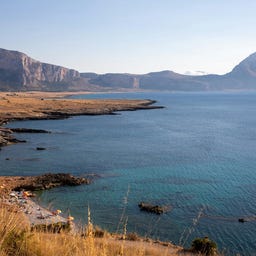
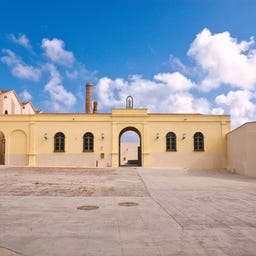
The former tuna processing plant is no ordinary museum. It tells the story of a time when tuna fishing defined life on the Aegadian Islands, and Favignana's tuna industry was one of the largest in the Mediterranean. In the late 19th century, Ignazio Florio revolutionized both the fishing and the preservation of tuna. Today, multimedia exhibits vividly bring to life the fishermen's tough existence and the brutal Mattanza—the traditional tuna hunt.
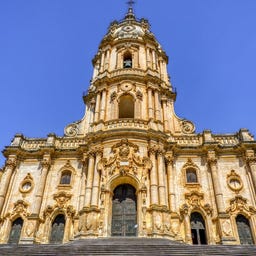
Majestically, the Duomo di San Giorgio towers over the Sicilian Baroque town of Modica, impressing with its 62-meter-high façade, which is considered one of the finest examples of Sicilian Baroque architecture. The history of the church dates back to the 12th century, but its current appearance was shaped after the devastating earthquake of 1693 during a 140-year construction period led by various architects, including Rosario Gagliardi.

Located along Via Etnea in the centre of Catania, the Bellini Gardens (Giardino Bellini) are the city's oldest and largest public park. Take a stroll between beautiful ornate stone paths, enchanting fountains and busts of notable Catanese musicians, writers, and politicians. The gardens also offer stunning views of Mt. Etna. It's a favored spot among students, couples, and locals alike.
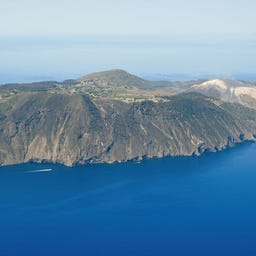
On the Aeolian island of Vulcano, you can find an active volcano, whose last eruption in the late 19th century halted sulfur production. The island, once dedicated to the god Vulcan and mentioned by Aristotle and Virgil, is home to two volcanic cones: the dominant Vulcano della Fossa and the smaller Vulcanello.
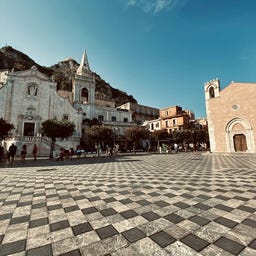
The Piazza IX Aprile is a charming square with awesome panoramic views of Mount Etna and the Mediterranean Sea. The square is home to the baroque Church of Saint Joseph and is lined with historic, picturesque buildings. Visitors can enjoy the peaceful atmosphere in the early morning before the area becomes vibrant with tourists and locals alike, enjoying the array of restaurants and cafes. Sip a coffee or aperitif, enjoy the live music and watch wedding processions, before heading to the Duomo.

Catania's fish market, located behind Piazza del Duomo, is a daily spectacle of fresh seafood and local life. Visitors are treated to a vivid display of Sicilian sea life, from massive swordfish to sea urchins, all amidst the lively banter of fishmongers and shoppers. To experience the market at its most animated, it's best to arrive early in the morning. It operates every workday morning until the early afternoon.
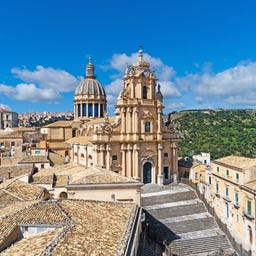
Majestically, the Duomo di San Giorgio stands at the end of an impressive staircase overlooking the old town of Ragusa - a masterpiece of Sicilian late Baroque from the 18th century. The cathedral, built by Rosario Gagliardi between 1739 and 1775, captivates with its monumental tower facade and characteristic dome, and is now part of the UNESCO World Heritage.
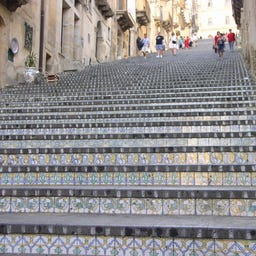
The majestic Scalinata di Santa Maria del Monte has connected the old and new parts of Caltagirone since the early 17th century with its 142 beautifully designed steps. Each step is adorned with colorful majolica tiles that reflect various artistic styles from the 10th to the 20th century.

At the Cathedral of Messina, you can see one of the largest astronomical clocks in the world, created in 1933 by the Strasbourg company Ungerer on behalf of Archbishop Angelo Paino. This impressive work in the bell tower not only tells the time but also features an eternal calendar and a mechanical planetary system, while biblical scenes change according to the liturgical calendar.

In the historic Kalsa district of Palermo, you will find the Giardino Garibaldi, a green oasis from the 1860s created in honor of the national hero Giuseppe Garibaldi. Designed by Giovan Battista Filippo Basile, the garden is home to the largest Ficus in Europe—an impressive specimen standing 30 meters tall with a crown spread of 50 meters in diameter.
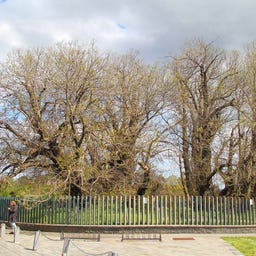
On the eastern slopes of Mount Etna stands one of the oldest and certainly the largest tree in Italy: the mighty chestnut tree "Castagno dei Cento Cavalli," with a circumference of 23 meters and a height of 22 meters.

Directly opposite the Cathedral of Sant'Agata, you will find one of the most significant Baroque buildings in Catania. The Chiesa della Badia di Sant'Agata, designed by architect Giovanni Battista Vaccarini, captivates with its wavy façade and was rebuilt after the devastating earthquake of 1693 on the ruins of an older church.
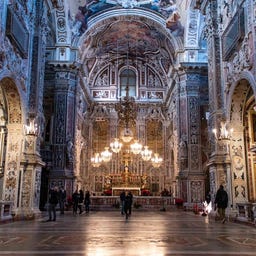
In the historic center of Palermo stands the Chiesa di Santa Caterina, an impressive testament to the Counter-Reformation with its late Baroque façade and grand staircase. Originally founded in 1310 and rebuilt in the 16th century, this church captivates with its lavish interior featuring marble, stucco, and frescoes, including the famous ceiling painting "Triumph of Santa Caterina" by Filippo Randazzo.
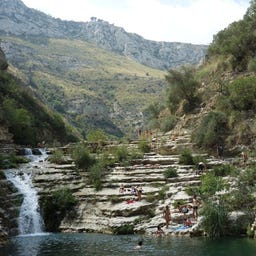
In the Cavagrande del Cassibile Nature Reserve, you will find one of the most impressive natural landscapes in Sicily, where the Cassibile River has carved its way up to 507 meters deep into the limestone cliffs. This 2,696-hectare protected area is home to over 400 plant species, as well as a system of refreshing waterfalls and natural pools, known locally as "uruvi."
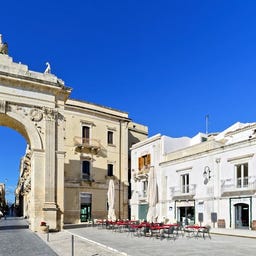
The Porta Reale is the iconic city gate of Noto and has marked the historical entrance to the Sicilian Baroque city since 1838. The Neapolitan architect Angelini designed this impressive structure for the visit of King Ferdinand II. of Bourbon, the ruler of the Two Sicilies at that time.

This remarkable historical site contains ruins from two ancient Roman theatres. Visitors can explore the tunnels and passageways behind the seating areas, offering a brief but fascinating glimpse into Roman architectural ingenuity. The visit will take around 30min. It's not as photogenic as the theatre in Taormina and Syracuse, but if you like ancient sites it may be worth a visit.
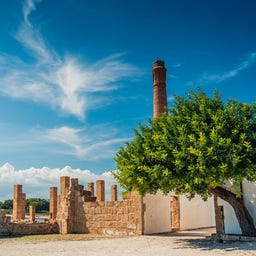
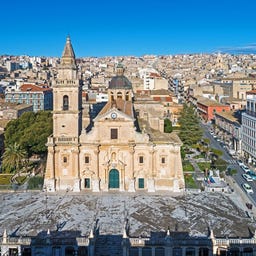
The majestic Cattedrale di San Giovanni Battista stands as the most important church overlooking the modern district of Ragusa and is part of the UNESCO World Heritage site "Late Baroque Towns of the Val di Noto." After the devastating earthquake of 1693, the cathedral was rebuilt in record time and continuously expanded throughout the 18th century.
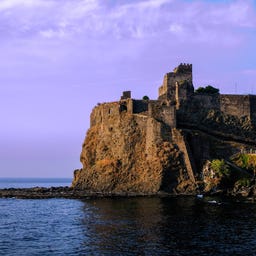
The Castello Normanno, or Castle of Aci, is situated on a volcanic rock in Aci Castello, just 9 km from Catania. Built in 1076 on the remnants of a Byzantine fortification, this Norman castle has stood the test of time, witnessing volcanic eruptions, sieges, and battles, including its role in the War of the Sicilian Vespers. Today, it houses a small museum with a model of the castle and a collection of local and rare rocks. Visitors can enjoy beautiful views of the sea and the surrounding city, making it a recommended stop for anyone in the area.
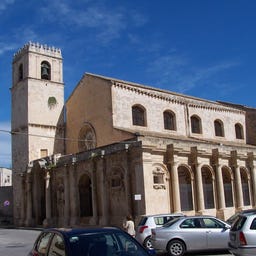
At the site where the holy Lucia was martyred in 304, today stands the Santuario di Santa Lucia al Sepolcro - an impressive blend of Norman, Renaissance, and Baroque architecture. The church, originally built in the 12th century, houses behind the altar the famous painting "Burial of Saint Lucia" by Caravaggio from 1608, as well as a statue of the saint by Gregorio Tedeschi from 1634.
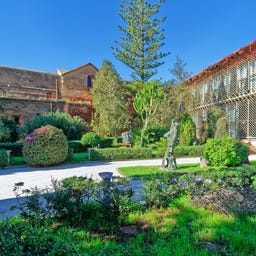
In the archaeological regional museum of Agrigento, you can expect a fascinating journey through the history of Sicily, housed in a building designed by architect Franco Minissi. Special highlights of the collection include the "Kouros of Agrigento" - a delicate marble sculpture from the early 5th century BC - as well as a reconstructed colossal Telamon from the Olympeion.
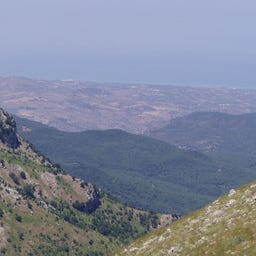
In the heart of Sicily, the Parco delle Madonie spans nearly 40,000 hectares of protected natural landscape, recognized as a UNESCO Global Geopark since 2015. Here, you can find an impressive botanical diversity with more than half of all Sicilian plant species, including many endemic plants like the rare Nebroden fir.
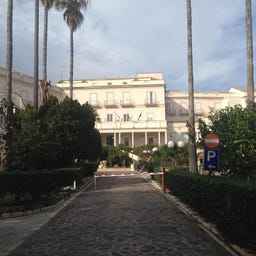
As the oldest grand hotel in Italy built specifically as a hotel, the Villa Politi has been majestically overlooking the ancient Latomia dei Cappuccini in Syracuse since 1862. Designed in the Liberty style by the Austrian noblewoman Maria Theresa Laudien, who married the Sicilian painter Salvatore Politi, the hotel has a rich history.

On the northern coast of Sicily, beneath the majestic Sanctuary of Tindari, the Riserva naturale orientata Laghetti di Marinello stretches over 400 hectares of protected natural area. This fascinating lagoon landscape, with its brackish water lakes, was shaped over the centuries by the constant influence of the Tyrrhenian Sea.
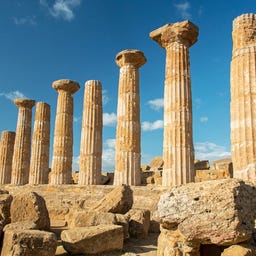
In the heart of the Valle dei Templi in Agrigento stands the Tempio di Eracle, one of the oldest Greek temples in the region, dating back to the late 6th century BC. Built in the archaic Doric style, this impressive structure measures 67 by 25 meters and was originally supported by six Doric columns at the front and 15 columns on each of the long sides.
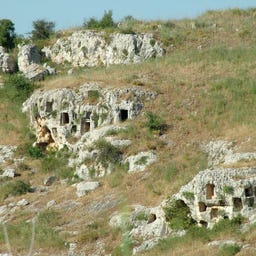
In the steep limestone cliffs of southeastern Sicily, you will find Pantalica, one of the most significant archaeological sites of the Bronze Age. The impressive necropolis, a UNESCO World Heritage Site since 2005, features around 5,000 rock-cut tombs dating from the 13th to the 8th century BC, reflecting the former Kingdom of Hybla.
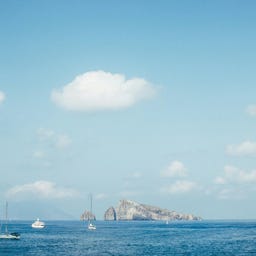
On the smallest of the Aeolian Islands, a Mediterranean gem awaits you, inhabited since the Bronze Age and now home to about 200 residents. Panarea impresses with its unique micro-archipelago of seven small islands and the prehistoric settlement of Capo Milazzese.
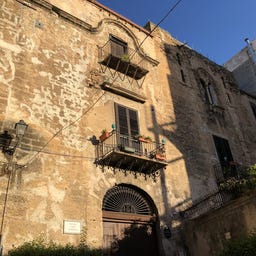
In the heart of Palermo stands the Palazzo Conte Federico, one of the oldest noble palaces in the city, still inhabited by Count Alessandro Federico. This impressive building houses the Torre Busuemi from the 12th century, an Arab-Norman tower that incorporates a former city gate.
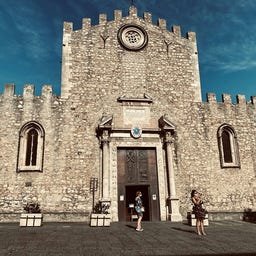
The Duomo of Taormina, also called Basilica of St. Nicholas of Bari, is located on a quaint piazza with great views, restaurants and a beautiful fountain. It's a popular spot for a break. The basilica dates back to the 13th century with characteristics of the Sicilian Romanesque-Gothic architecture.
Inside, take note of the detailed Last Supper depiction in front of the altar and the Polyptych of Antonello de Saliba from 1504, featuring religious figures and scenes. The structure itself is simple, with a Latin cross, with three naves and three apses. The central nave is supported by six columns of pink Taormina marble with leaf-patterned capitals and fish scales. It is thought that these may come from the Greek-Roman theater of Taormina.
